Explore the essence of Nepali snacks, a key element of the country's rich and varied culinary culture, as we go on a culinary adventure with the Kathmandu Cooking Academy. This extensive guide delves into the plethora of delectable Nepali sweets that are a must-try, encompassing both traditional and well-liked snacks found in Nepal, such as the colorful selection of street cuisine. Discover the best Nepali snacks that capture the essence of Nepali cuisine through authentic flavors and ingredients. We'll introduce you to simple yet delicious Nepali snack recipes, celebrate the variety of authentic Nepali snacks, and share the joy of Nepali festival snacks. Whether you're craving homemade Nepali snacks, seeking vegetarian Nepali options, or in search of the perfect Nepali tea time snacks, our guide promises a taste of Nepal's culinary excellence. From spicy Nepali snacks to sweet treats in Nepal, get ready to indulge in an unforgettable snacking experience. Join us as we celebrate the extraordinary flavors of Nepal, a treasure trove of gastronomic delights waiting to be discovered.
Our academy is uniquely positioned to offer an unparalleled culinary experience, blending traditional techniques with modern culinary practices. We understand that Nepali snacks are not just food; they are a gateway to understanding the culture, traditions, and flavors that make Nepal truly unique. From the intricacies of preparing the perfect Momo to mastering the art of crafting Sel Roti, our experienced instructors guide you through each step, ensuring a hands-on learning experience that is both informative and enjoyable. Whether you're a seasoned chef looking to expand your repertoire or a culinary enthusiast eager to explore new flavors, Kathmandu Cooking Academy is your best choice for diving deep into the world of Nepali snacks. Our commitment to authenticity, combined with a warm, welcoming environment, makes us the ideal partner in your culinary journey. Join us to discover the must-try treats of Nepal and take home not just recipes, but memories that will last a lifetime.
Variety of Momos
In the heart of Nepali snack culture, Momos reign supreme as a versatile and beloved treat, capturing the essence of Nepal's culinary diversity. "Savoring Nepali Snacks: A Guide to Must-Try Treats" delves into the fascinating world of Momos, showcasing the variety that makes these dumplings a must-try for any food enthusiast. Here’s a closer look at the variety of Momos featured in our exploration:

-
Vegetable Momos: A delight for vegetarians, these Momos are filled with a finely chopped mixture of vegetables seasoned with herbs and spices, offering a fresh and flavorful bite.
-
Chicken, Beef, and Pork Momos: Catering to meat lovers, these Momos are stuffed with minced chicken, beef, or pork, combined with Nepali spices, providing a hearty and satisfying snack.
-
Cheese Momos: A fusion twist on the traditional recipe, these Momos contain a gooey center of cheese, sometimes mixed with vegetables, appealing to those with a love for cheese.
-
Buff Momos: A local favorite, Buff Momos are filled with buffalo meat, offering a richer and more robust flavor, reflecting Nepal's traditional meat preferences.
-
Jhol Momos: Served in a savory, spicy broth, Jhol Momos are a comforting and warming version of the classic dumpling, perfect for cooler weather or as a soulful meal.
-
Fried Momos: For those who enjoy a bit of crunch, Fried Momos are crispy on the outside, with a succulent filling inside, offering a delightful textural contrast.
-
Tandoori Momos: Marinated in a tandoori sauce and then grilled, these Momos offer a smoky, spicy twist on the traditional dumpling, perfect for those seeking bold flavors.
-
Chocolate Momos: A sweet variant, these Momos are filled with chocolate, serving as a unique dessert option for those with a sweet tooth.
"Savoring Nepali Snacks: A Guide to Must-Try Treats" celebrates the incredible variety of Momos, demonstrating their versatility and the creativity of Nepali cuisine. Each type of Momo offers a different taste experience, from spicy and savory to sweet and decadent. Kathmandu Cooking Academy invites you to explore the world of Momos, whether by tasting them in the bustling streets of Kathmandu, enjoying them in a local eatery, or learning to make them in one of our cooking classes. Embrace the joy of discovering the diverse flavors of Momos, a cornerstone of Nepali snack culture.
Chatamari
Within the pages of "Savoring Nepali Snacks: A Guide to Must-Try Treats," Chatamari, often heralded as the 'Nepali Pizza,' receives special attention for its unique place in Nepali cuisine. This traditional Newari dish, originating from the Kathmandu Valley, exemplifies the fusion of simplicity and flavor that characterizes Nepali snacks. Here's a closer examination of Chatamari and why it's a must-try treat:
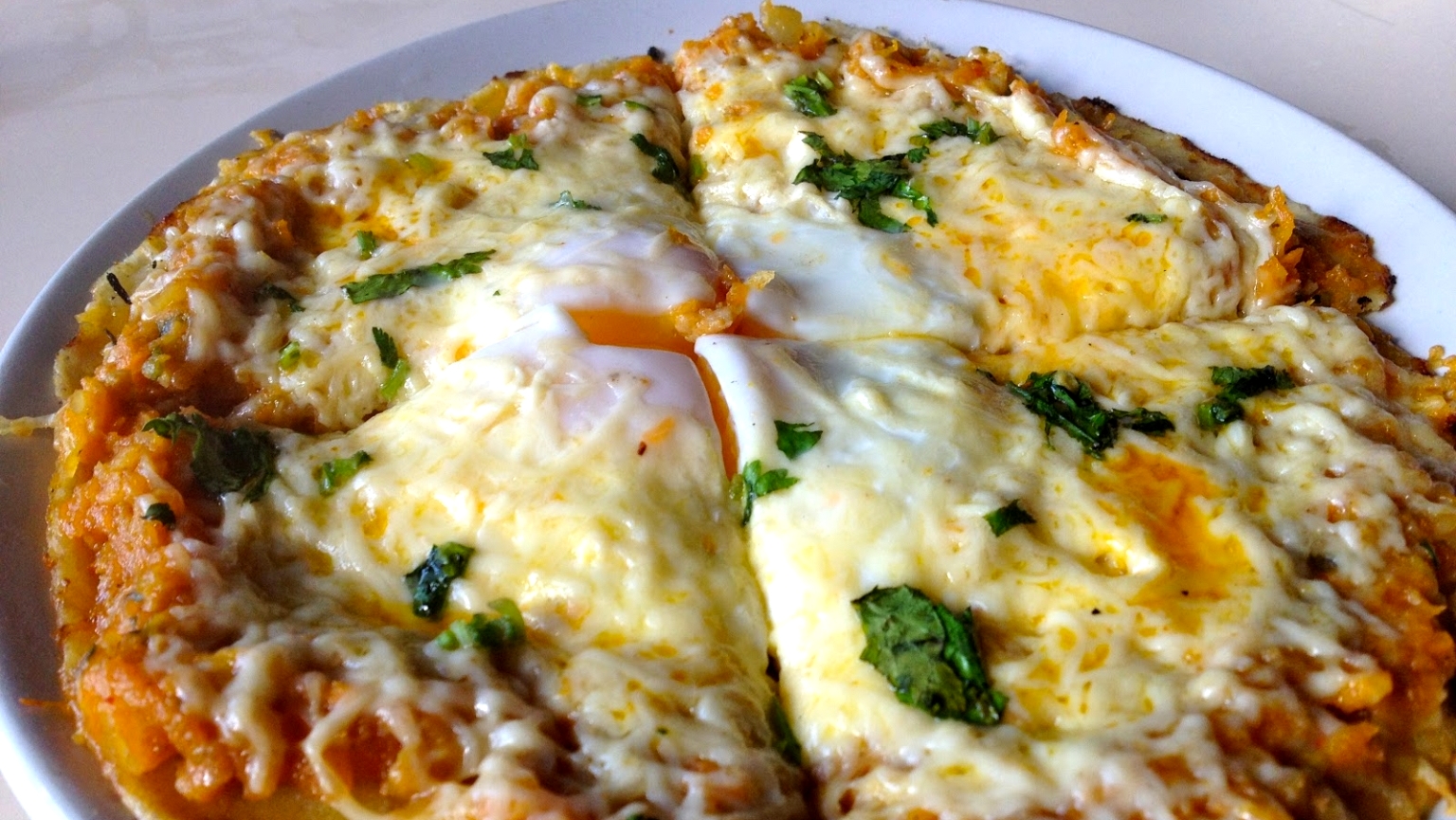
-
Base and Preparation: Chatamari is crafted from a thin, crepe-like base made of rice flour batter, which is skillfully spread onto a hot pan to achieve its characteristic crispness and lightness. This delicate base serves as a canvas for a variety of toppings.
-
Variety of Toppings: The versatility of Chatamari comes to life with its toppings, which can include minced meat (chicken, pork, or buffalo), chopped vegetables, eggs, and a mix of Nepali spices. The combination of these fresh ingredients melds together as it cooks, creating a harmonious blend of flavors.
-
Vegetarian Options: Embracing Nepal's rich tradition of vegetarian cuisine, Chatamari can also be made with an array of vegetable toppings, making it a welcoming option for vegetarians and vegans alike. Spinach, tomatoes, onions, and bell peppers are popular choices, often seasoned with turmeric, cumin, and coriander.
-
Cultural Significance: Beyond its delightful taste, Chatamari holds cultural significance, especially among the Newar community of the Kathmandu Valley. It's not only a popular snack but also a staple during festivals and celebrations, embodying the communal spirit and culinary heritage of Nepal.
-
Modern Twists: While traditional Chatamari remains beloved, contemporary chefs and home cooks alike have introduced modern twists to this classic dish, experimenting with new toppings and flavors to cater to a broader palette. From cheese and mushrooms to more innovative combinations, Chatamari continues to evolve.
"Savoring Nepali Snacks: A Guide to Must-Try Treats" by Kathmandu Cooking Academy celebrates Chatamari as a prime example of Nepali culinary innovation and tradition. Its versatility, combined with the depth of flavor, makes Chatamari a quintessential Nepali snack that everyone should try. Whether enjoyed in the cozy eateries of Patan, savored during a traditional Newari feast, or prepared at home with your personal touch, Chatamari is a testament to the rich, diverse culinary landscape of Nepal.
Samosas
"Savoring Nepali Snacks: A Guide to Must-Try Treats" pays homage to one of the most universally beloved snacks that have found a special place in the heart of Nepali cuisine: the Samosa. This deep-fried pastry, with its savory filling, epitomizes the fusion of cultures and flavors that characterize South Asian cuisine and has been warmly embraced in Nepal, making it a popular choice among locals and visitors alike. Here's what makes Samosas a must-try treat in Nepal:
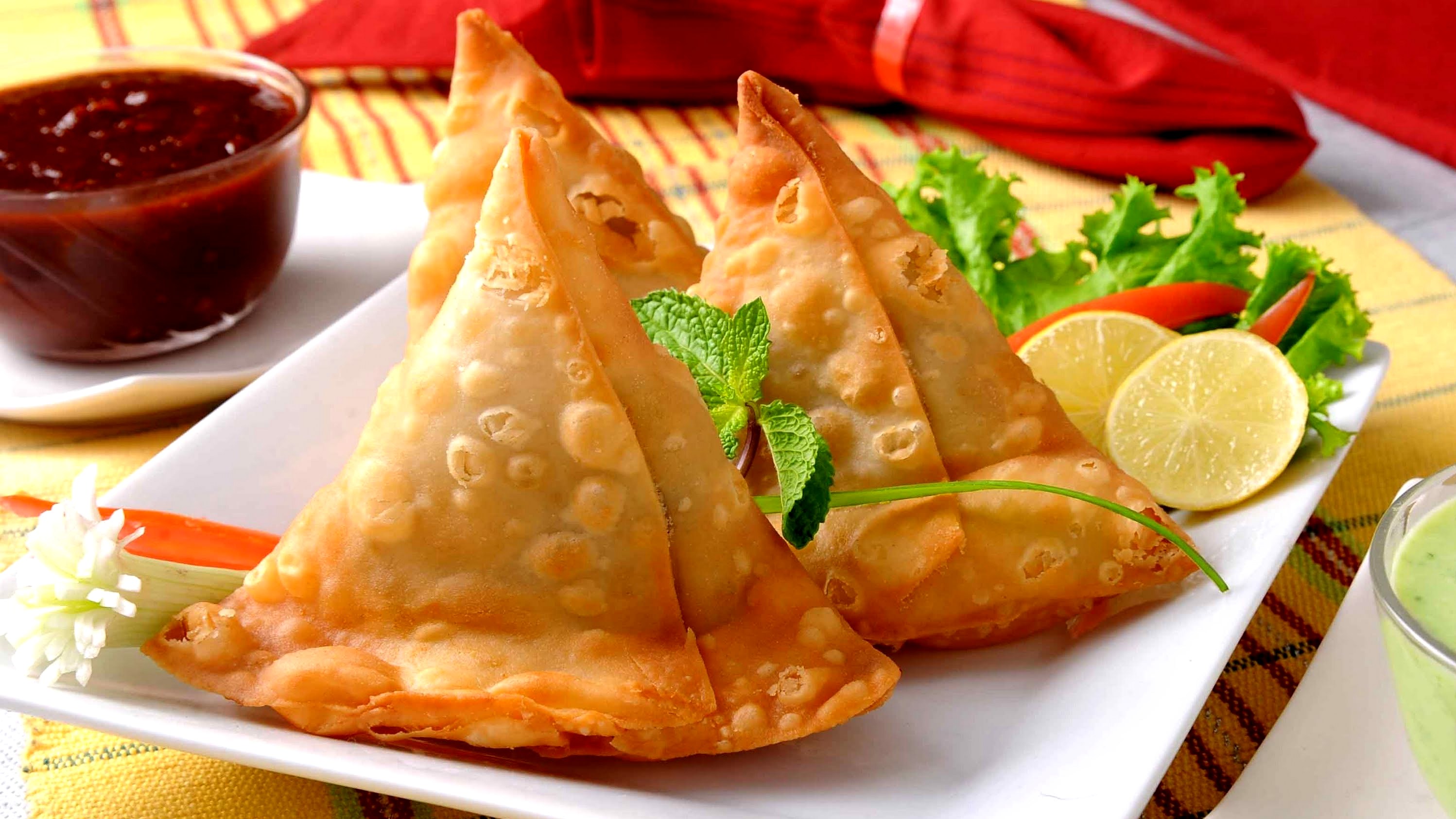
-
Crispy Pastry: The outer shell of a Samosa is crafted from a thin layer of dough, meticulously folded into a triangular shape before being deep-fried to golden perfection. This process ensures a crispy texture that gives way to a burst of flavors from the filling within.
-
Savory Fillings: Typically, the filling consists of spiced potatoes, peas, onions, and sometimes lentils or ground meat, all seasoned with a blend of Nepali herbs and spices such as cumin, coriander, and garam masala. The result is a mouth-watering mixture that perfectly balances spice and flavor.
-
Vegetarian-Friendly: While there are meat versions, the most common Samosas in Nepal are vegetarian, aligning with the dietary preferences of many Nepalis and visitors. The spiced potato filling is not only delicious but also comforting, making it a favorite snack at any time of the day.
-
Served with Chutneys: No Samosa experience is complete without the accompaniment of chutneys. In Nepal, Samosas are often served with a variety of chutneys, ranging from sweet tamarind to spicy green chili or mint, adding layers of flavor that enhance the overall tasting experience.
-
Street Food Staple to Café Delight: From bustling street vendors in Kathmandu’s alleys to the sophisticated cafes and restaurants, Samosas are omnipresent, testifying to their wide appeal. Each place offers its version, from the traditional to more gourmet options, showcasing the snack's versatility.
-
Cultural Integration: Though not originally from Nepal, Samosas have been thoroughly embraced by Nepali culture, demonstrating the country's openness to culinary influences and its ability to make those influences its own. This integration speaks volumes about Nepal's diverse and inclusive food culture.
In "Savoring Nepali Snacks: A Guide to Must-Try Treats," Kathmandu Cooking Academy celebrates the Samosa not just as a snack but as a cultural icon that brings people together, irrespective of their background. It's a snack that perfectly encapsulates the joy of Nepali street food - simple, flavorful, and deeply satisfying. Whether you're navigating the streets of Thamel or enjoying a leisurely afternoon in Bhaktapur, the Samosa is a treat that promises a taste of Nepal's rich culinary mosaic.
Sel Roti
In "Savoring Nepali Snacks: A Guide to Must-Try Treats," Sel Roti emerges as a quintessential Nepali treat that combines the art of traditional cooking with the sweetness of celebration. This deep-fried, ring-shaped, rice doughnut is much more than just a snack; it's a cultural emblem of Nepal, integral to festivals, religious ceremonies, and daily life. Here’s a deep dive into the significance and allure of Sel Roti:

- Unique Preparation: Sel Roti is meticulously prepared from a batter of ground rice, water, sugar, and spices such as cardamom and cloves, creating a blend that is both aromatic and flavorful. The batter is then deep-fried in a ring shape, requiring a skilled hand to achieve its distinctive texture and appearance.
- Crispy and Sweet: The perfect Sel Roti boasts a crispy exterior with a soft, slightly chewy interior, offering a delightful contrast in textures. The sweetness, accentuated by the spices, makes it a favorite among both children and adults, serving as a comforting treat at any time.
- Cultural Significance: More than just a culinary delight, Sel Roti holds profound cultural significance in Nepal, especially during major festivals like Dashain and Tihar. It is a symbol of goodwill, shared among families and neighbors, and offered in pujas (worship rituals) as a sacred offering.
- Versatility in Consumption: While delicious on its own, Sel Roti can also be paired with various accompaniments such as yogurt, vegetable curries, or aloo ko achar (spicy potato pickle), making it a versatile snack that can cater to different tastes and meal times.
- Homemade Tradition: Traditionally made in homes during festive occasions, the preparation of Sel Roti is a communal activity, bringing families together. The process of making Sel Roti is passed down through generations, preserving the culinary heritage of Nepal.
- Availability: While deeply rooted in tradition, Sel Roti has found its way into the hearts and streets of urban Nepal, available in local markets and from street vendors, especially during festival times, making it accessible to everyone wishing to partake in its sweet, crispy goodness.
"Savoring Nepali Snacks: A Guide to Must-Try Treats" by Kathmandu Cooking Academy shines a spotlight on Sel Roti not just as a snack, but as a testament to Nepal's rich culinary traditions and the deep-seated significance of food in its cultural fabric. This guide invites readers to explore the depths of Nepali cuisine, starting with the sweet, circular delight of Sel Roti, a treat that encapsulates the warmth, hospitality, and vibrancy of Nepali culture.
Pani Puri
"Pani Puri," a chapter within "Savoring Nepali Snacks: A Guide to Must-Try Treats," delves into one of the most exhilarating and beloved street food snacks not only in Nepal but across the Indian subcontinent. Pani Puri, known for its explosive burst of flavors and textures, offers an unforgettable snacking experience that has won the hearts of many. Here's what makes Pani Puri a standout treat in Nepali snack culture:
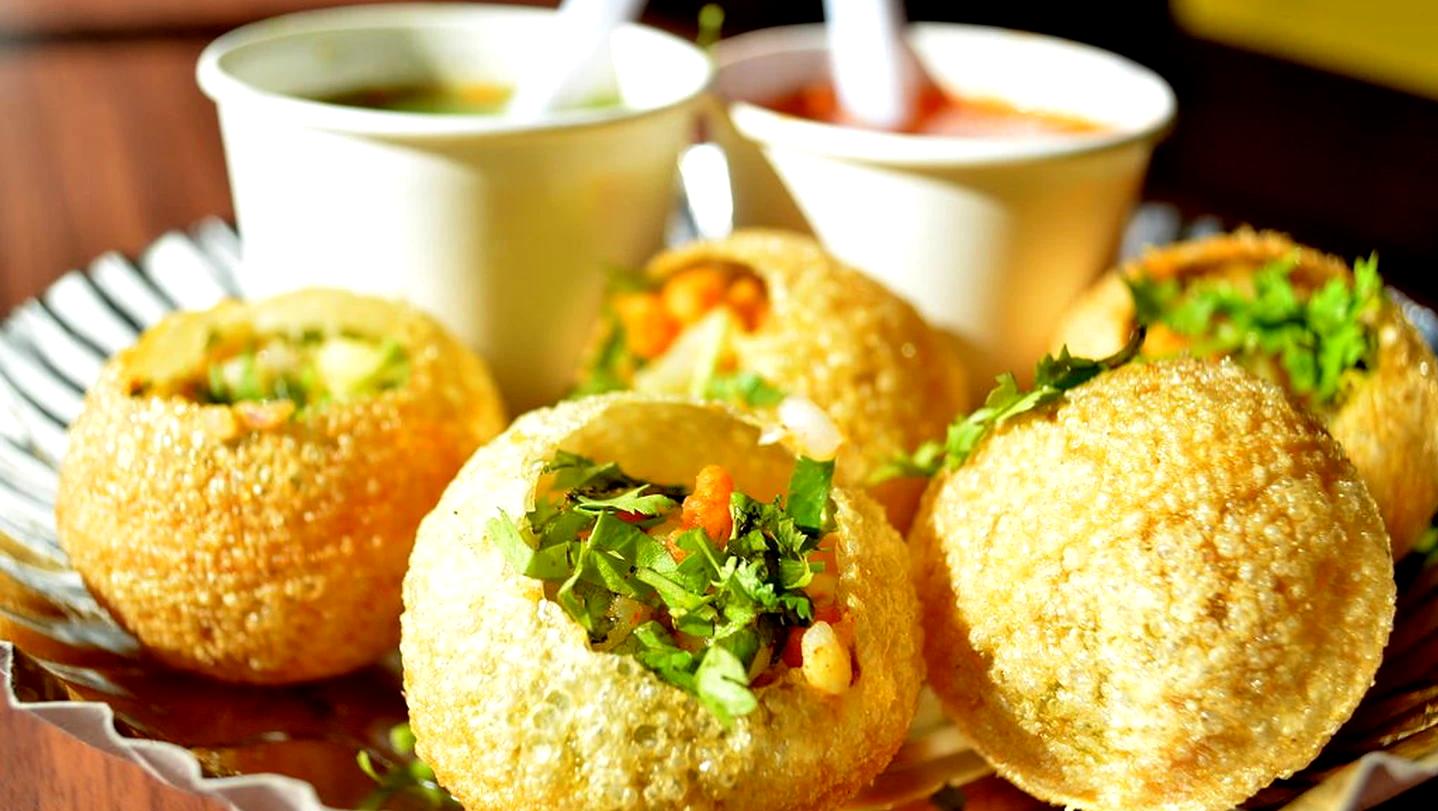
- Explosive Flavor Experience: The essence of Pani Puri lies in its combination of flavors and textures. A small, round, hollow puri is filled with a mixture of flavored water (pani), tamarind chutney, chili, chaat masala, potato, onion, and chickpeas. The result is a mouthful of spicy, tangy, and sweet flavors, complemented by the crispness of the puri and the softness of the fillings.
- Variety and Adaptability: While the basic components of Pani Puri remain consistent, variations abound depending on regional preferences and individual tastes. In Nepal, the pani often includes a blend of local herbs and spices, making it uniquely Nepali. Variations in the fillings and the level of spiciness allow for a personalized snacking experience.
- Communal Snacking Ritual: Eating Pani Puri is almost always a communal affair, enjoyed with friends and family at street-side stalls, where it is served one piece at a time, ensuring each puri is consumed whole and fresh. This ritual adds to the enjoyment, making it more than just a snack but a shared experience.
- Street Food Staple: Pani Puri epitomizes Nepali street food culture, available at almost every market, festival, and bustling street corner. The sight of vendors expertly assembling these delicate treats, and the queues of eager customers, is a common and vibrant part of urban life in Nepal.
- Accessibility and Affordability: One of the most appealing aspects of Pani Puri is its accessibility and affordability, making it a snack that is enjoyed by people from all walks of life. It embodies the democratic spirit of street food, where everyone can enjoy a flavorful experience without spending a lot.
- Cultural Significance: Though Pani Puri is not originally from Nepal, it has been wholeheartedly adopted into Nepali snack culture, illustrating the fluidity and inclusiveness of Nepali cuisine. It represents a culinary crossover that has become a staple in the Nepali diet, celebrated and enjoyed by many.
In "Savoring Nepali Snacks: A Guide to Must-Try Treats," Kathmandu Cooking Academy highlights Pani Puri as a testament to the joy and diversity of Nepali street food. This guide encourages readers to explore the rich tapestry of flavors that Pani Puri offers, celebrating it as a beloved snack that brings people together, igniting their taste buds with every bite. Whether you're navigating the streets of Kathmandu or enjoying the festivities of a local celebration, Pani Puri stands out as a must-try treat, promising a deliciously memorable experience.
Laphing
In "Savoring Nepali Snacks: A Guide to Must-Try Treats," Laphing is spotlighted as a unique and flavorful snack that has captured the hearts of food lovers in Nepal, especially in the Kathmandu Valley. Originating from Tibetan cuisine, Laphing has seamlessly integrated into Nepali snack culture, offering a distinct taste and texture that stands out among the myriad of Nepali street foods. Here's a glimpse into the world of Laphing:
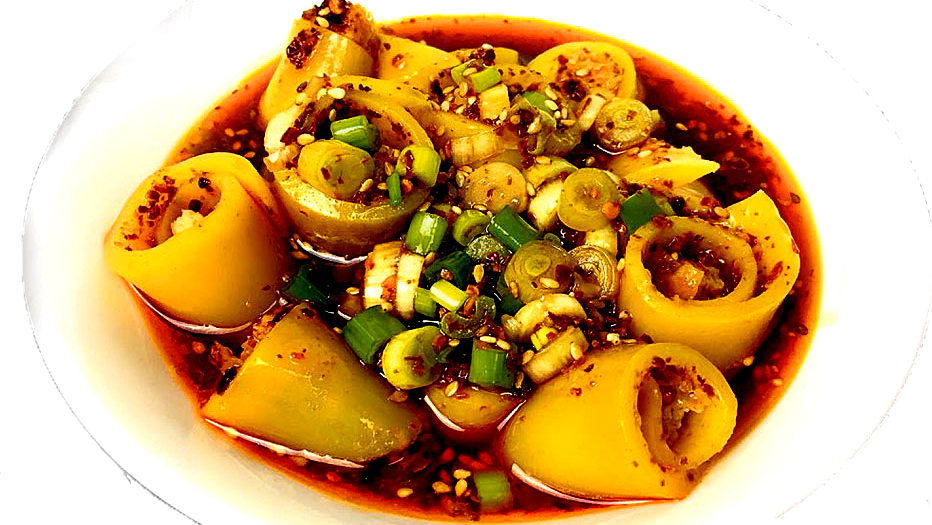
- Unique Texture and Flavor: Laphing is known for its unique, jelly-like texture, made from mung bean starch or wheat flour. It's served cold and comes in various forms, including rolls and flat noodles, seasoned with a spicy and savory sauce that includes vinegar, soy sauce, chili oil, and a mix of herbs and spices, creating a tantalizing flavor profile.
- Variations of Laphing: While the traditional Laphing is served cold and spicy, there are several variations to cater to different palates. Some include additions like minced meat or vegetables, offering a more substantial snack. Additionally, there's a dry version, where the Laphing is not doused in sauce but rather mixed with spices and seasonings, providing a different texture and flavor experience.
- Culinary Fusion: Laphing's presence in Nepal is a beautiful example of culinary fusion and the blending of cultures. Initially brought to Nepal by Tibetan immigrants, it has been embraced by the Nepali people, becoming a popular snack in Kathmandu and beyond. This integration highlights the dynamic nature of Nepali cuisine and its openness to diverse flavors and influences.
- Street Food Favorite: Laphing has become a staple in the street food scene of Kathmandu, often found in areas with a strong Tibetan influence. It's celebrated for its bold flavors and the cooling sensation it provides, especially during the warmer months, making it a refreshing choice among the array of spicy and hot snacks available.
- Cultural and Social Aspect: Enjoying Laphing is not just about savoring its flavors but also about the cultural and social experience. It's commonly eaten in groups, sharing the joy of discovering its unique taste and texture, and is often a topic of conversation among locals and travelers alike, fostering a sense of community and mutual culinary appreciation.
"Savoring Nepali Snacks: A Guide to Must-Try Treats" by Kathmandu Cooking Academy introduces Laphing as a must-try for anyone looking to explore the depth and diversity of Nepali snacks. This guide aims to not only provide a taste of Nepal's culinary delights but also to highlight the stories and cultural exchanges that shape its food culture. Laphing, with its intriguing texture, bold flavors, and cross-cultural heritage, is a perfect representation of the vibrancy and richness of Nepali street food, inviting everyone to delve into its delicious complexity.
Yomari
"Savoring Nepali Snacks: A Guide to Must-Try Treats" introduces readers to Yomari, a distinct and cherished delicacy in Newar culture, celebrated especially during the Yomari Punhi festival, marking the end of the rice harvest. This sweet treat not only delights the palate but also carries deep cultural and spiritual significance within the Newar community of the Kathmandu Valley. Here's an in-depth look at Yomari and its special place in Nepali cuisine:
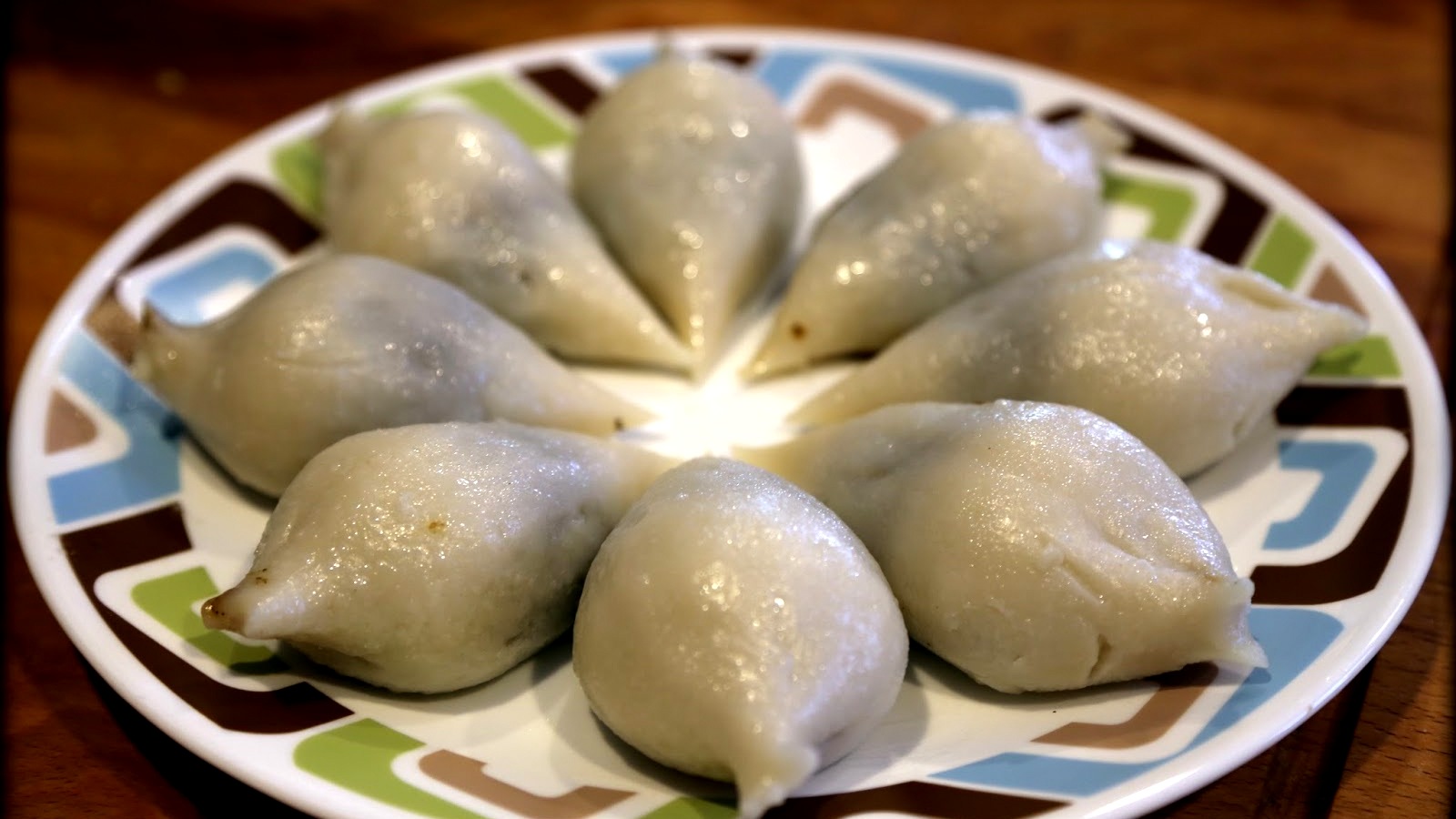
- Symbolic Shape and Ingredients: Yomari is characterized by its unique fish or fig shape, made from a dough of rice flour and filled with a sweet mixture of chaku (molasses) and sesame seeds or a savory filling of lentils. The shape of Yomari is said to symbolize prosperity, and its ingredients are a testament to the seasonal bounty.
- Cultural Significance: The making and sharing of Yomari are central to the Yomari Punhi festival, a celebration that brings families and communities together. It's believed that offering Yomari to the gods and goddesses during this festival will bring blessings and prosperity. This tradition reflects the rich cultural heritage and the intertwining of food with religious and community practices in Nepal.
- Handcrafted with Tradition: Each Yomari is carefully handcrafted, requiring skill and patience, particularly in shaping the dough to achieve its signature look. This art is passed down through generations, preserving the traditional methods and the cultural essence of the Newar community.
- Taste and Texture: The contrast between the soft, delicate outer shell and the rich, sweet, or savory filling makes Yomari a unique gastronomic experience. The sweetness of chaku, combined with the nuttiness of sesame seeds, offers a comforting warmth, while the savory version provides a pleasant contrast, catering to different taste preferences.
- Beyond Festivals: While Yomari is traditionally associated with the Yomari Punhi festival, its popularity has grown, and it is now enjoyed year-round in many Newari homes and restaurants throughout Kathmandu. This expansion reflects the evolving nature of Nepali cuisine while staying rooted in tradition.
"Savoring Nepali Snacks: A Guide to Must-Try Treats" by Kathmandu Cooking Academy celebrates Yomari as a symbol of Nepali culinary artistry and cultural heritage. This guide aims to bring to light the profound connection between food, culture, and community in Nepal, inviting readers to explore the depth of flavors and traditions through Yomari. Whether sweet or savory, Yomari offers a window into the soul of Newar cuisine, making it a must-try for anyone wishing to experience the true essence of Nepali festive treats.
Keema noodles
In "Savoring Nepali Snacks: A Guide to Must-Try Treats," Keema Noodles emerge as a heartwarming and flavorful dish that exemplifies the fusion of traditional Nepali flavors with modern culinary preferences. This dish combines the hearty, spiced essence of keema (minced meat) with the beloved texture and comfort of noodles, creating a savory snack or meal that resonates with locals and travelers alike. Here's what makes Keema Noodles a standout in the realm of Nepali cuisine:

- Flavorful Fusion: At its core, Keema Noodles is a harmonious blend of spicy minced meat—commonly chicken, mutton, or buffalo—and noodles, seasoned with a medley of Nepali spices such as cumin, coriander, turmeric, and garam masala. This fusion brings together the rich flavors of Nepali keema and the universally loved texture of noodles for a dish that is both comforting and exciting to the palate.
- Versatility and Adaptability: The beauty of Keema Noodles lies in its versatility. It can be customized with various vegetables, such as bell peppers, onions, and peas, making it a well-rounded dish that can cater to different dietary preferences and nutritional needs. The choice of meat and level of spiciness can also be adjusted, allowing for a personalized eating experience.
- Cultural Blend: While noodles might not traditionally be part of ancient Nepali cuisine, their integration into modern Nepali dishes like Keema Noodles represents the evolving nature of the country's culinary landscape. This dish is a testament to Nepal's openness to external culinary influences while still maintaining the integrity of its traditional flavors.
- Popularity Across Settings: Keema Noodles is not confined to any one setting. It's enjoyed in homes as a beloved comfort food, in street food stalls as a quick and satisfying snack, and in restaurants as part of a larger meal. Its widespread appeal underscores its status as a staple dish within the contemporary Nepali food scene.
- Homemade and Street Food Versions: Whether prepared at home with a family recipe or savored from a bustling street vendor in Kathmandu, Keema Noodles provide a delicious experience. The homemade version allows for a deeper connection with the cooking process and ingredients, while the street food version offers a glimpse into the dynamic and flavorful world of Nepali street cuisine.
"Savoring Nepali Snacks: A Guide to Must-Try Treats" by Kathmandu Cooking Academy places Keema Noodles among the must-try dishes for anyone looking to explore the rich and varied landscape of Nepali cuisine. This dish, with its delightful combination of flavors, textures, and cultural influences, invites food enthusiasts to dive into a culinary adventure that bridges the traditional and the contemporary, making it a perfect representation of the vibrant and evolving nature of Nepali snacks.
Sausage
In the rich tapestry of Nepali cuisine that "Savoring Nepali Snacks: A Guide to Must-Try Treats" explores, Sausages occupy a special place, reflecting both traditional practices and contemporary tastes. In Nepal, sausages are not just a simple food item; they are a delicacy that varies from region to region, incorporating local flavors and ingredients, and showcasing the diversity of the country's culinary landscape. Here's a closer look at the role and variety of sausages in Nepali snacks:

- Traditional Varieties: One of the most traditional forms of Nepali sausage is the Sukuti, which is dried meat (usually buffalo or goat) seasoned with a blend of Himalayan spices and then either smoked or sun-dried. While not a sausage in the conventional sense, Sukuti shares the preservation and flavoring principles that are foundational to sausage-making. Another traditional variety is the Chhoyela, prepared by marinating and grilling diced meat, which is then spiced, bearing resemblance to some sausage preparations in its seasoning and serving methods.
- Newari Influence: The Newar community, indigenous to the Kathmandu Valley, has a profound influence on Nepali sausage-making. Their version, known as Swan Puka, is a fermented sausage made from minced meat, fat, and a mixture of local spices, encased in the animal's intestine. This delicacy highlights the Newari's expertise in meat processing and preservation, offering a taste that is deeply savory and richly spiced.
- Commercial Sausages: Alongside traditional varieties, Nepal has seen the rise of commercial sausages, which include a range of flavors from mildly spiced to very hot, catering to the Nepali palate's love for chili and spices. These are often enjoyed as quick snacks, grilled or fried, and served with dipping sauces or within sandwiches and momos, reflecting a fusion of global and local tastes.
- Festival and Celebration Food: In many Nepali cultures, sausages are considered a delicacy and are particularly enjoyed during festivals and celebrations. They are often part of the feasts during Dashain and Tihar, Nepal's major festivals, symbolizing abundance and joy.
- Cooking Methods: The versatility of Nepali sausages extends to the ways in which they can be prepared. From grilling over open flames, and imparting a smoky flavor, to frying in spices for a rich, caramelized texture, the cooking methods enhance the unique flavors of the sausages, making them a beloved snack or side dish in Nepali cuisine.
"Savoring Nepali Snacks: A Guide to Must-Try Treats" by Kathmandu Cooking Academy celebrates the variety and cultural significance of sausages within Nepali cuisine. It invites readers to explore the depth of flavors and traditions encapsulated in these delicacies, from the traditional Sukuti and Swan Puka to the more accessible commercial variants. Sausages in Nepal are not just food; they are a testament to the country's rich culinary heritage and the ongoing dialogue between tradition and modernity in its food culture.
"Savoring Nepali Snacks: A Guide to Must-Try Treats" by Kathmandu Cooking Academy offers a comprehensive journey through the rich and diverse world of Nepali snacks, from the traditional to the contemporary, the savory to the sweet. This guide highlights the importance of snacks like Momos, Chatamari, Samosas, Sel Roti, Pani Puri, Laphing, Yomari, Keema Noodles, and Sausages in reflecting Nepal's cultural heritage and culinary innovation. Each snack detailed in the guide not only tantalizes the taste buds but also tells a story of cultural significance, communal traditions, and the fusion of flavors that make Nepali cuisine unique. Kathmandu Cooking Academy invites readers to explore, taste, and appreciate the vast palette of flavors that Nepali snacks offer, ensuring a deliciously memorable experience that goes beyond mere eating to embracing the rich tapestry of Nepal's food culture.


